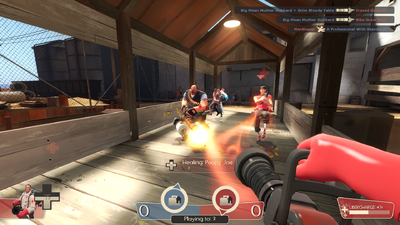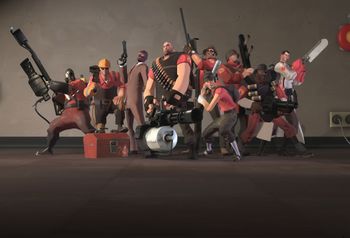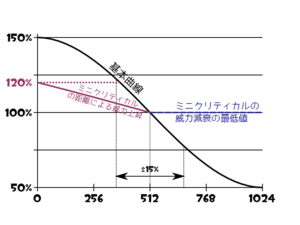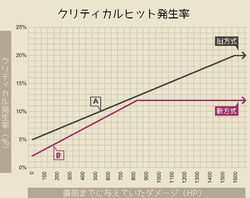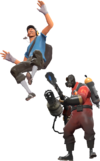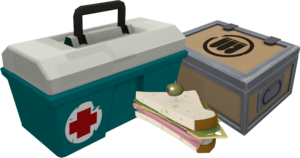メカニクス
| このページの内容は日本語へ翻訳中です。 もしあなたが日本語話者で編集して頂ける場合は、トークページにその旨を記していただくか(編集履歴のページを参照して)このページを過去に編集した人たちと話してください。 |
| 「 | これが手本だ!
聴く
— TF2の成功の秘訣を伝授するソルジャー
|
」 |
Team Fortress 2 のメカニクスはプレイヤー、サーバーおよびコンテンツ製作者が可能なことのルールを定めるものです。これらの仕組みを理解することで、より高度で白熱したゲームプレイを楽しめることでしょう。
目次
ゲームエンジン
Team Fortress 2 はオレンジボックス版のSource エンジンで動作しており、ウィンドウズ、Xbox 360、PlayStation 3、Mac OS X および Linux 向けに設計されています。オレンジボックスエンジンは「ハードウェア・フェイス・レンダリング」機能や柔らかな粒子の表現、マルチコア・レンダリング機能などを搭載しています。TF2は最大24人またはそれ以下の人数(Xbox版は18人、PS3版は16人)でのプレイに焦点を当てて作られています。PCおよびMac版では最大32人対戦のサーバーも作成可能です。全てのプレイヤーの行動とオプションはコンソールコマンドから制御することが可能です。
クラス
Team Fortress 2 には9つのクラスがあり、それぞれ「攻撃」、「防御」、「サポート」の3つのカテゴリに分けられていまが、あくまで目安でありゲームプレイには影響を及ぼしません。各スラスの能力や性能は装備を変更することで変えることができます。
 スカウト: 攻撃クラス。133%の移動速度と125のヘルスポイントをもち、ヒット・アンド・アウェイ戦法や目標の確保に長けている。ダブルジャンプとコントロールポイントのキャプチャ速度(およびペイロードのカートを押す速度)が2倍という特殊能力を持つ。初期装備は散弾銃、ピストル、バット。
スカウト: 攻撃クラス。133%の移動速度と125のヘルスポイントをもち、ヒット・アンド・アウェイ戦法や目標の確保に長けている。ダブルジャンプとコントロールポイントのキャプチャ速度(およびペイロードのカートを押す速度)が2倍という特殊能力を持つ。初期装備は散弾銃、ピストル、バット。
 ソルジャー: 攻撃クラス。80%の移動速度と200のヘルスポイントをもち、攻防両面において状況を選ばず柔軟に能力を発揮する。ロケットジャンプで通常では行けない場所へ行くことが可能。初期装備はロケットランチャー、ショットガン、シャベル。
ソルジャー: 攻撃クラス。80%の移動速度と200のヘルスポイントをもち、攻防両面において状況を選ばず柔軟に能力を発揮する。ロケットジャンプで通常では行けない場所へ行くことが可能。初期装備はロケットランチャー、ショットガン、シャベル。
 パイロ: 攻撃クラス。100%の移動速度と175のヘルスポイントをもち、接近戦と集団のサポートに長けている。敵を炎に包む、圧縮空気で敵を吹き飛ばす、延焼ダメージを受けないという特殊能力を持つ。初期装備は火炎放射器、ショットガン、消防斧。
パイロ: 攻撃クラス。100%の移動速度と175のヘルスポイントをもち、接近戦と集団のサポートに長けている。敵を炎に包む、圧縮空気で敵を吹き飛ばす、延焼ダメージを受けないという特殊能力を持つ。初期装備は火炎放射器、ショットガン、消防斧。
 デモマン: 防御クラス。93.33%の移動速度と175のヘルスポイントをもち、爆発物を用いた「面」の制圧に長けている。粘着爆弾ジャンプの特殊能力を持つ。初期装備はグレネードランチャー、粘着爆弾ランチャー、ボトル。
デモマン: 防御クラス。93.33%の移動速度と175のヘルスポイントをもち、爆発物を用いた「面」の制圧に長けている。粘着爆弾ジャンプの特殊能力を持つ。初期装備はグレネードランチャー、粘着爆弾ランチャー、ボトル。
 エンジニア: 防御クラス。100%の移動速度と125のヘルスポイントをもち、「面」の制圧と支援に長けている。装置を作成し、維持し、性能を向上させ、移動させる特殊能力を持つ。初期装備はショットガン、ピストル、スパナ、PDA。
エンジニア: 防御クラス。100%の移動速度と125のヘルスポイントをもち、「面」の制圧と支援に長けている。装置を作成し、維持し、性能を向上させ、移動させる特殊能力を持つ。初期装備はショットガン、ピストル、スパナ、PDA。
 メディック: サポートクラス。106.67%の移動速度と150のヘルスポイントをもち、味方の体力を回復させ、前線を維持することに長けている。体力が自動で回復し、味方の体力の回復とユーバーチャージにより自身と仲間を無敵化させる特殊能力を持つ。初期装備は注射銃、メディガン、電動骨ノコ。
メディック: サポートクラス。106.67%の移動速度と150のヘルスポイントをもち、味方の体力を回復させ、前線を維持することに長けている。体力が自動で回復し、味方の体力の回復とユーバーチャージにより自身と仲間を無敵化させる特殊能力を持つ。初期装備は注射銃、メディガン、電動骨ノコ。
 スナイパー: サポートクラス。100%の移動速度と125のヘルスポイントをもち、遠距離から敵を倒すことに長けている。ヘッドショットを行う特殊能力を持つ。初期装備はスナイパーライフル、SMG、ククリ刀。
スナイパー: サポートクラス。100%の移動速度と125のヘルスポイントをもち、遠距離から敵を倒すことに長けている。ヘッドショットを行う特殊能力を持つ。初期装備はスナイパーライフル、SMG、ククリ刀。
 スパイ: サポートクラス。100%の移動速度と125のヘルスポイントをもち、隠密行動による敵の妨害と暗殺に長けている。変装、サッパーの設置、透明化、ヘッドショット(アンバサダー装備時のみ)、バックスタブの特殊能力を持つ。初期装備はリボルバー、サッパー、ナイフ、変装キット、透明ウォッチ。
スパイ: サポートクラス。100%の移動速度と125のヘルスポイントをもち、隠密行動による敵の妨害と暗殺に長けている。変装、サッパーの設置、透明化、ヘッドショット(アンバサダー装備時のみ)、バックスタブの特殊能力を持つ。初期装備はリボルバー、サッパー、ナイフ、変装キット、透明ウォッチ。
戦闘
このゲームにおいて「戦闘」とは敵対する2つのチームが「目標」をめぐって争うために行われます。Team Fortress 2 においては戦闘に影響を与える様々な要素があります。
ダメージ
ほとんどの武器は敵のヘルスにダメージを与えることができます。サーバーが特別に設定を行っていない限り、味方にダメージを与えることはありませんが、自分自身は受けます。多くの武器は与えるダメージに一定のブレがあります(スナイパーとスパイのヘッドショットおよびスパイのバックスタブを除く)。ほとんどの武器は敵との距離が近いほどダメージが増し、逆に遠いほど減少します。ただしミニクリティカルは例外で、近づくことによる威力の上昇はあれど、どれだけ離れていてもダメージが減少することはありません。威力は攻撃したプレイヤーとそれを受ける敵との間の距離に依存して変化します。これは最初に攻撃を発射した位置で決定されるので、攻撃を発射した後に敵に近づいてもダメージが増加したりすることはありません。爆発ダメージは爆心地と敵との距離により変化します。爆発ダメージの多くはプレイヤー自身にもダメージを与えますが、ソルジャーとデモマンは自身の攻撃によるダメージに対して耐性を持っています。
サーバーによって無効化されない限り、多くの武器のダメージはランダムに最大±15%増減し、半ランダムにクリティカルヒットになります。クリティカルヒットはランダムなダメージの増減や威力による増減の影響を受けず、常に武器の基本ダメージの300%のダメージを与えます。クリティカル攻撃はチームカラーの電気のような音とエフェクトをまといます(特に爆発物が顕著)。直前までに敵に与えていたダメージ量によって変化しますが、通常、近接攻撃以外は2~12%、近接攻撃は15~25%のクリティカル発生率をもちます。しかし例えばマーケット・ガーデナーのような武器はランダムクリティカルヒットが発生しません。クリティカル攻撃が敵にヒットすると、敵の頭上にそれを表すテキストが表示され、特徴的なサウンドが再生され、敵は大きく吹き飛ばされます。クリティカル攻撃による自爆は、上述のテキストとサウンドがでますが、通常の攻撃となんら変わりなく、追加のダメージやノックバックの増加もありません。クリティカルヒットを単一の攻撃に重ねがけすることはできません。
武器の中にはミニクリティカルを引き起こすものがあります。ミニクリティカルはクリティカルヒットと似ていますが、基本ダメージの最大135%のダメージを与え、ノックバック量も少なく、テキストやサウンドも独自のものになります。また、クリティカルヒットはどんな距離からでも一定のダメージを与えるのに対し、ミニクリティカルは敵との距離が近いほど威力が増加します。ミニクリティカルとクリティカルヒットの発生条件が重なった場合、通常のクリティカルヒットとして扱われます。クリティカル攻撃のように、ミニクリティカルによる自爆は通常のものとなんら変わりありません。
装置はクリティカルヒットやミニクリティカルおよび距離によって受けるダメージは増加しません。同様に、装置による攻撃も距離による威力の増減、クリティカルおよびミニクリティカル化することはありません。
当たり判定
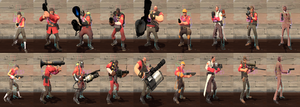
ほとんどの武器は「発射物」と「即着弾」の二種類に分けられます。
- 発射物系武器とは、たとえばロケットランチャーのような、発射するとハッキリ目に見える形で投射物が飛んでゆくタイプのもので、サーバーによってその位置やエフェクトが決定され、プレイヤーのレイテンシーが低いほどサーバーへの依存度が低くなるものです。発射された「投射物」にはプレイヤーとは異なる物理法則が働いており、プレイヤーの速度によって投射物の初速が変化することはありません。また、画面の中央から発射されるのではなく、武器を持っている手の方から発射されます。たとえば右手にロケットランチャーを構えたソルジャーがロケットを発射すると、画面右側から飛んでいくという具合です。投射物の当たり判定はモデル通りではなく、プレイヤーやマップに使われているのと同じ、単一の大きなヒットボックスとなっており、しゃがみ状態を除いてプレイヤーのクラスや状態に基づいて変化しません(たとえば走っているヘビーと直立状態のスカウトは同じ投射物へのあたり判定を有しますが、しゃがんでいると異なります)。パイロの火炎放射攻撃はパーティクルに基づいたもので、ほぼ投射物系武器と同じ仕組みとなっています。
- 即着弾系武器とは、たとえばミニガンのような、即座に当たり・外れが計算される種類のものです。近接武器と銃弾やペレットを発射する武器のほとんどがこれに当たります。即着弾系武器の当たり判定は攻撃したプレイヤーの状態によって決定されるため(投射物はサーバーに依存する)、すこし曖昧なあたり判定の計算が行われます(そのため「壁に隠れたはずなのに、どうやって当ててきたんだ?」といったことがしばしば起こります)。即着弾系武器の銃弾は、見た目は異なっていても、必ず画面中央からまっすぐ飛んでいきます。近接武器以外の即着弾系武器は完全にモデル通りの当たり判定を持っていますが(たとえば直立するヘビーは同じく直立するスカウトよりも大きな当たり判定を持つ)、近接武器は発射物系武器と同じ当たり判定を持ちます。
武器の種類
各クラスには固有の武器があり、それらは1、2、3のスロット(それぞれプライマリ、セカンダリ、近接武器と呼ばれることが多い)に装備されます。クラスによっては追加のスロットがあり、エンジニアのPDAやスパイの変装キットがそれにあたります。プレイヤーは装備画面から武器や装飾品アイテムを選択することができます。
ほとんどの非近接武器は弾薬を必要とします。またそこからさらに弾倉を持つタイプ(ピストルのように弾倉に入る弾の数が決まっていて、撃ち尽くすとリロードが必要になる)と弾倉をもたないタイプ(ミニガンのように弾が無くなるまで、リロードせずに撃ち尽くせるもの)の二種類に分けられます。そこからさらに弾倉ありタイプの武器はリロードの方式によって、マガジン式(リボルバーのように一動作で完全にリロードできるもの)と、一発一発弾を込めるもの(ショットガンなど)の二種類に分けられます。リロードの動作は途中で攻撃あるいは武器の変更を行うことでいつでも中断可能ですが、中断した場合はもちろんリロードは完了しません。一発一発弾を込めるタイプのものは初弾と次弾以降では動作が異なるため、装填速度が変わります(グレネードランチャーを例にすると、初弾は1.24秒かかるが二発目以降は0.6秒でリロードしていく)。
多くの武器には使用可能になるまでにリチャージを必要とするものがあります(ジャラテなど)。リチャージは一定時間待つことで行われますが、リスポーンルームの補給ロッカーに触れることによって即座に行うこともできます。また、弾薬を必要とせず、特定の動作によって手動でチャージしていくものも多く存在します(ヒールには必要ないがユーバーチャージの発動にチャージが必要なメディガンやバフ・バナーなど)。
様々なステータス効果
ステータスエフェクトは武器によって引き起こされる様々な状態の総称で、例えば炎上や出血状態などがあります。全てのステータスエフェクトは死亡する、補給ロッカーに触れる、クラスを変更するなどで無くなり、悪影響を及ぼすエフェクトの多くはユーバーチャージによって無くせます。また、ヒールを受ける、水中に潜るなどしても無くせるものがあります。エフェクトには良いものと悪いものの二種類があります。
好影響を及ぼすステータス
- ユーバーチャージ: ユーバーチャージ中のプレイヤーは環境ダメージとテレフラグを除く全てのダメージを無効化します。ユーバーチャージ中のプレイヤーはチームカラーに輝き、目も光ります。ユーバーチャージ状態になるにはメディガンで発動する、Eyeaduct の地下世界あるいは Ghost Fort のスカル・アイランドから脱出する、Merasmus を爆弾でスタンさせることで可能です。
- メガヒール: メガヒール効果中のプレイヤーは移動妨害効果(ノックバック、スタン、速度低下など)を無効化し、また、HPをクイックフィックスの基本回復レートの3倍に当たる秒間100.8~302.4ポイント回復します(プレイヤーの直前までの被ダメージ量に依存)。メガヒール効果中のプレイヤーはバフ・バナーのように足元に光の輪がでます。メガヒール状態になるにはクイックフィックスのユーバーチャージを発動することで可能です。
- クリティカルブースト: クリティカルブースト効果中のプレイヤーが放つ全ての攻撃はクリティカルヒットになり、プレイヤーの武器がチームカラーでバチバチと光ります。クリティカルブースト状態になるにはクリッツクリーク、キリング・グローブ・オブ・ボクシング、フロンティア・ジャスティス、ダイアモンドバック、チャージン・タージ、スプレンディッド・スクリーン、フロギスティネーター、クリーナーズ・カービンといった武器の効果を受けるほか、機密情報をキャプチャする、ファースト・ブラッドの直後、Haunted Halloween Special のハロウィーンのカボチャを拾う、Eyeaduct の地下世界あるいは Ghost Fort のスカル・アイランドから脱出する、チームが勝利したときの虐殺タイム中といった際もクリティカルブースト状態になります。カウ・マングラー 5000はたとえクリティカルブースト状態であってもクリティカルヒットがでません。
- ミニクリティカルブースト: ミニクリティカルブースト効果中のプレイヤーが放つ全ての攻撃はミニクリティカルになり、プレイヤーの武器が黄色がかったチームカラー(BLUは緑っぽい色、REDはオレンジっぽい色)でバチバチと光ります。ミニクリティカルブースト状態になるにはクリティコーラ、バフ・バナー、チャージン・タージ、スプレンディッド・スクリーン、バッファロー・ステーキ・サンドヴィッチといった武器の効果を受けることで可能です。
- オーバーヒール: オーバーヒール効果中のプレイヤーはヘルスが100%を超え(上限は150%)、チームカラーの十字のパーティクルをまといます。オーバーヒール状態になるにはメディガン、クリッツクリーク、ヴァクサネーター、アイランダー/ネッシーズ・ナインアイアン/ホースレス・ヘッドレス・ホースマンズ・ヘッドテイカー、パワージャック、コンナイバーズ・クナイ、Dalokohs バー/フィッシュケーキといった武器の効果を受けるほか、Eyeaduct の地下世界から脱出することで可能です。
- 無敵(回避状態): 無敵状態は敵の攻撃からダメージを回避して受けなくなりますが、衝撃によるノックバックやステータス効果は受けてしまいます。無敵効果中のプレイヤーは残像を放ち、攻撃を受けると "Miss!" の文字が頭上に表示されます。無敵状態になるにはBonk! アトミックパンチを使用する以外にはありません。
- Hypeモード: Hypeモード状態のプレイヤー(スカウトのみが可能)は5段ジャンプを行うことができ、武器が紫色に光ります。この状態になるにはソーダ・ポッパーを装備する必要があります。
- Speed Boosted: A 40% speed boost is applied, which caps at 150% of the basic move speed. Speed-boosted players are indicated by a wind breeze particle effect surrounding them. Received by Disciplinary Action, the buff from The Concherer, and escaping from Eyeaduct's Underworld or Ghost Fort's Skull Island you also receive a brief speed boost from crossing the light bridge and going through the door next to the Clocktower on Helltower.
- Damage Softening: Players benefiting from damage softening receive reduced damage and knock back from Critical hits and mini-crits, and take an additional 35% reduced weapon damage overall. Such players have a glowing ring around their feet (an effect shared by the Buff Banner's Crit boost effect). Received by the Battalion's Backup.
- Resistance: Players can have 1 of 3 resistance types deployed on them. Those resistance types are called Bullet Resistance, Blast Resistance and Fire Resistance. These Resistance types can be deployed as an ÜberCharge with the Vaccinator equiped.
悪影響を及ぼすステータス
- Fire: A burning player takes damage over time (an effect known as Afterburn), to which Pyros are immune. From most sources, this deals 3 damage every half-second over 10 seconds for a total of 60 damage (Degreaser only deals 2 damage at a time, totaling 40). Received by the Flamethrower, Backburner, Degreaser, Phlogistinator, Rainblower, ignited arrows, Flare Gun, Detonator, Manmelter, Scorch Shot, Sharpened Volcano Fragment, Huo-Long Heater and the charged shot from the Cow Mangler 5000.
- Bleeding: Bleeding players take damage over time. Bleeding duration is based on the source (either 5 or 6 seconds), dealing 3-5 damage every half-second. Received by the Southern Hospitality, Tribalman's Shiv, Boston Basher, Three-Rune Blade, Flying Guillotine and the projectile (bauble) from the Wrap Assassin.
- Slowdown: Some weapons can reduce enemy movement speed on hit, with varying efficacy. Received by Natascha.
- Jarate: Attacks made against Jarate-soaked players become mini-crits. Jarate-soaked players are tinted yellow and drip yellow droplet particles, which partially reveals cloaked Spies. Recieved by Jarate and the Sydney Sleeper.
- Milk: Players who attack Milk-soaked enemies are healed for 60% of the damage dealt (does not overheal). Milk-soaked players drip white droplet particles, and partially reveal cloaked Spies. Recieved by Mad Milk.
- Fleeing State: Fleeing players move 10% reduced speed, cannot move while crouched, and cannot fire or change weapons (although they can taunt). Such players can be recognized by their change in character animations, which vary by class (most can be characterized as looking "frightened" or "disappointed"). Recieved by the Sandman, humiliation, Ghosts, and the Horseless Headless Horsemann's "taunt".
- Marked For Death: Attacks made against players who are Marked For Death become mini-crits. A player who is marked for death has a white skull and crossbones image above their head. Players are Marked for 15 seconds by being hit by a Scout wielding the Fan O'War, with each Scout only being able to mark one enemy at any time. Unlike Jarate, Mark For Death can't be removed by being submerged in water, nor being healed by Medic. The only cure is touching a Resupply Locker or to wait 15 seconds. Heavies are Marked For Death while using the Gloves of Running Urgently, and for three seconds after switching weapons. Engineers are marked for death when hauling a building with the Rescue Ranger equipped (whether picked up from a distance or not), and for a few seconds afterward.
- Honorbound: When a player draws an Honorbound weapon that player is unable to unsheathe this weapon away until he scores a kill with it. Once a kill is earned, the player may draw and sheath the weapon as he pleases. The Half-Zatoichi is currently the only weapon that is Honorbound.
ノックバック
Most weapons produce at least some sort of knock back, much of which is too small to notice. Attack modifiers to knock back include damage, critical hit or mini-crit status, and weapon-specific effects. Knockback can be used to manipulate the positioning and movement of players, especially those of enemies through juggling and oneself through rocket jumping or sticky jumping. Some weapons and abilities, such as the Force-A-Nature and compression blast, are based on unique knock back functionality. ÜberCharged targets are less influenced by enemy knock-back than normal targets, and Megahealed players and Disguised Spies are not subject to knock back from enemy weapons with the exception of the compression blast.
環境
Depending on the map and server, the goals and rules of TF2 gameplay can change dramatically. By understanding these variables in gameplay (and how to parse them in the Server Browser), players can find a game environment that suits them and fully contribute to their team's goals.
オブジェクト
Maps are made based on a variety of game modes, which are used to determine the objectives for both teams. Teams may compete over the same goals (such as in Push Control Point and King of the Hill maps) or oppose each other in an offense vs. defense setup (such as in Attack/Defend Control Point and standard Payload maps).
Many game modes use control points. Control points begin to be captured when a player of a team not owning the point stands on the point. The capture time varies by map, and its speed is increased when more players stand on it (though each player beyond the first provides diminishing returns). Capture is halted when an opposing team member stands on it in defense, and capture progress is gradually undone when no capturing team mates stand on the point. Control points cannot be captured while "locked", and locked points are usually unlocked after preceding points are captured. Payload carts are pushed and halted the same way control points are captured, though instead of capturing a Payload cart, the pushing team tries to bring it to a checkpoint. Übercharged players cannot capture points or push carts, though they can defend them.
In all official maps with offense vs. defense game modes, BLU plays offense while RED plays defense. In such maps, BLU tends to have faster respawn times, but RED is given a setup time to prepare a robust defense.
- Arena: Players spawn only at the beginning of the round, with no respawning. After a set time, a neutral control point unlocks, which can be captured to win the round. If all members of a team die, that team loses the round. Has First Blood and automated team assignment/shuffling by default. Official arena maps don't have resupply Lockers.
- Capture the Flag (CTF): Teams work to capture the opposing side's Intelligence faster than their opponents do the same. Any player can pick up an enemy's Intelligence, and their team gains a point if that player returns the enemy's Intelligence to their team's own original Intelligence spot. The Intelligence drops on command or when its carrier dies; it is returned to its original location if it remains on the ground for a set time after being dropped.
- Control Point, Push (CP): Each team starts with two locked control points and fight for the middle, neutral control point. From then on, at any given time, each team's furthest control point is unlocked, while all others are locked. Teams must capture all five control points to win the round.
- Control Point, Attack/Defend (CP): If the offensive team captures all of the defense's control points before time runs out, they win (if defense can prevent this, they win). In most maps, only one or two control points are unlocked at a time (the notable exception being Steel).
- King of the Hill (KOTH): Each team has their own countdown timer, and a team wins when their countdown timer reaches zero. A team's timer counts down while they own the control point, but is frozen while that team does not have ownership of the control point. Note that a team's timer will still count down even if there are enemies trying to capture the point.
- Mann vs. Machine (MVM): A team composed of up to six human players must fend off waves of AI-controlled robots, stopping them from deliver a bomb to the map's stronghold. Players are able to collect cash from destroyed robots and buy upgrades between waves. Offense wins if successfully deliver the bomb, while defense wins by successfully Ward off all the waves.
- Payload (PL): Offense pushes the Payload cart in a manner similar to capturing a control point, trying to reach checkpoints instead of finishing point captures. The Payload cart supports allies as if it were a level 1 Dispenser. Offense wins if the cart reaches the final checkpoint, while defense wins by making sure the cart doesn't reach the final point before the timer counts down to 0 .
- Payload Race (PLR): Essentially identical to Payload, but instead of offense vs. defense, each team pushes their own cart in an attempt to reach the finish before the opposing team does.
- Special Delivery (SD): CTF-streetball, an initially neutral briefcase of Australium must be transported to Poopy Joe's rocket before the opposing team can do the same.
- Territorial Control (TC): Each team is randomly assigned territories, and rounds consist of each team trying to contest one of their opponent's control points (while the opposing team tries to capture one of theirs). Most of the map is locked during gameplay, consisting of only one territory vs. one territory. After enough successive wins, a round takes place at the losing side's base point, which they must defend against the offense-only opposing team.
- Training Mode (TR): Training maps are for practicing skills against obstacles and/or bots and learning through tutorials. They are often played with only one human player, or at the very least, no opposing human sides.
マップ内の要素
Players start the round in their team's respawn room, where they can change class and loadout instantly. Most respawn rooms contain resupply cabinets, which fully restore health, restock weapon ammo, refill most item meters, and remove most negative status effects, though a similar effect can be achieved by class switching. Upon dying, a player waits to respawn in a respawn wave, which typically come at ten- or five-second intervals, but do vary by map, team color and size, objective status, and server settings. After this wait they appear at their team's furthest forward respawn room. Respawn rooms can be earned by capturing points or pushing Payload carts to checkpoints, and can be lost if the opposing team makes such progress themselves.
Many maps make use of doors. Although their visuals suggest otherwise, doors are handled by the server as being either completely open or completely shut, alternating between the two instantly. Most doors are opened whenever a player stands near them. However, some doors will only open to players coming from a certain side or players on a certain team, most notably respawn room doors. Some doors remain locked until certain conditions are met, such as control points being captured or Payload cart checkpoints being reached.
The boundaries and surfaces of maps are not determined by visual elements, but invisible surfaces that determine where players and projectiles can go. All maps--even outdoor ones--have player ceilings and walls, though they may be invisible, and projectiles may even appear to go through them. Additionally, many surfaces and objects in the game that appear to take physical space are completely ignored for collision detection, with players and projectiles passing through them as if nonexistent; these surfaces can be used for hiding Stickybombs or spamming targets from cover.
Maps usually have pickups placed in various locations. Map-specific health and ammo pickups will remain in place until grabbed, respawning after a ten-second delay. The map health pickups restore 20.5%, 50%, or 100% health based on size (pill bottle, first aid tin, and ice cooler, respectively); similarly, the map ammo pickups restore 20.5%, 50%, or 100% ammo and 41, 100, or 200 metal based on size (small grey metal box, medium beige metal box, and large wood crate, respectively). When players die, they usually drop weapons that can be picked up for 50% ammo and 100 metal (unless the dropped item was an Engineer toolbox, which drops 100% ammo and 200 metal); destroyed buildings also leave behind metal debris, which can be picked up for ammo and metal. A Heavy who dies with a Sandvich, Dalokohs Bar, Fishcake, or Buffalo Steak Sandvich active will instead drop that, which can be picked up for 50 health points (75 for Scouts).
サーバー設定

Server settings can have a strong impact on gameplay in terms of performance and game balance. Players can select what kind of server on which they want to play using the Server Browser, filtering based on tags (which include game modes and changes to respawn times), player count, map, latency, and the like. Generally, servers closer to the player's location will have reduced latency, resulting in faster connection and more accurate hit detection. Game smoothness is also affected by the server's hardware and networking settings, especially at higher player counts or when running some mods.
Servers can run scripts and configs just as a player can, with commands from clients issued by rcon. For more unique functionality, there are numerous server plugins to modify gameplay or provide administrative or stat assistance, the most common being SourceMod and HLStatsX. Instead of running plugins, servers can use logs to interact with third-party match-making programs, such as TF2 Lobbies, which let them see stats out-of-game.
There are a variety of server settings that can change gameplay without running plugins or external programs. These include:
- Respawn times: Respawn times can be changed to either be shorter or effectively removed entirely. These can cause fluctuations in map and class balance, though combat is more steadily provided.
- Damage settings: Servers can disable random Critical hits, random damage spread, and random pellet spread with ConVars. This is most commonly done on competitive servers and those that frequently play arena maps.
- Max players: While TF2 was originally designed for 24 players or fewer, servers can raise the limit to 32 at the cost of performance. This can cause in increase of spam that slows objective progress, but ensures a greater amount of combat in the map.
- Objective specifics: Map objectives can be specified from the server. For example, the CTF game mode can be played to a certain capture count, to a certain time limit, or both. Related options include disabling Crit boosts from First blood or Intelligence capture, changing the map time limit, and using a win difference mercy rule.
- Pure: The sv_pure ConVar dictates what kinds of custom files are allowed on the server. When set to 0, clients can use any custom content they wish. When set to 1, clients are allowed to use any files on the server's whitelist. When set to 2, clients may not use any custom content besides those specifically allowed by Valve.
- SourceTV: Servers can enable SourceTV to allow a large number of spectators to watch the game without risking interference. SourceTV acts like an observer player, taking up a server slot while not playing on either team. Unlike players, SourceTV broadcasts its spectator view from the server's IP address (using a different port).
- Special modes: There are server modes that can be applied to any map regardless of game mode, including highlander and tournament modes. These are more commonly reserved for private events and competitions.
Other common rule areas that vary by server include team size/balance rules, alltalk (cross-team) voice chat, and ping limits.
コンフィグ設定
There are a variety of ways to configure the Team Fortress 2 client. The choices players make in setting up TF2 can have impacts on game interaction, performance, and presentation. Most of these methods of customization are not available on console versions of the game, save main menu options.
プログラムのセットアップ
Some aspects of a player's machine, operating system, and Steam settings can affect TF2, and after a long history of updates, Team Fortress 2 has required an increasing amount of system resources to play at optimum frame rates. Additionally, some program features enabled by default may be undesirable for certain players, either due to performance issues or personal preference.
Steam, by default, enables both Steam Cloud synchronization and the Steam Community In-Game Overlay, which can be changed under Steam Settings. Within Steam's interface, players can also change launch options. As the name suggests, launch options are TF2 settings that are applied when the game is launched. Launch options can be accessed by opening the Properties of Team Fortress 2 in the Steam Library and clicking "Set Launch Options...". Launch options are separated by spaces and start with either a dash (if the command is not accessible through console commands]) or a plus sign (if the command is a console command). Launch options can be used to achieve a variety of effects, including...
- Smooth Alt+Tabbing: Players who wish to view other windows and programs while running TF2 can run it in windowed mode with no border. This can be reversed with the full-screen launch option (-full). Example (for 1440x900 resolution): -window -noborder -w 1440 -h 900
- DirectX Level: Due to performance or personal preference, running TF2 in a low DirectX level may be ideal. Example (for DirectX 8.1): -dxlevel 81
- Disabling Extraneous Features: Memory usage and performance drops can be minimized by disabling unused features. Example: -novid -nojoy -noipx -nocrashdialog
In addition to the Steam options, launch options can be specified for individual shortcuts to Team Fortress 2 by adding them to the file "C:\Program Files\Steam\Steam.exe" -applaunch 440 as a shortcut target. For example, this shortcut target would run TF2 full-screen with no intro video:
"C:\Program Files\Steam\Steam.exe" -applaunch 440 -full -novid
Video card and sound card configuration tools can be used to override game settings. For example, some video card utilities can change mat_picmip to values outside the normally-allowed bounds in Team Fortress 2, though this can be considered cheating.
Team Fortress 2 can be subject to operating system influences on mouse control. While this can be mitigated through launch options and registry edits, the easiest method to override this is by enabling Raw input (m_rawinput 1).
カスタム
The most straightforward way for a player to customize their TF2 experience is the in-game options panels. In essence, the options panels are user-friendly ways to set ConVars, which can otherwise by set manually using the developer console. These panels are...
- Keyboard: Allows for simple key binding (can be done in command console with bind "KEY" "COMMAND"). The advanced options allow for fast weapon switching (change slots without confirming with the attack key) and enabling developer console (an important option for anyone using console commands).
- Mouse: Contains options for mouse and gamepad control. The "Raw input" option gives users more reliable mouse aiming by bypassing operating system mouse settings.
- Audio: Has a variety of sound-related options. Closed captions do not work without custom files.
- Video: Allows for some control of display settings, though some settings found in launch options and FPS configs are missing or disabled. The advanced video options panel has the field of view (fov) slider, which can be increased to grant the player wider vision in-game.
- Voice: Has simple controls for in-game voice chat.
- Multiplayer options: Contains a great variety of gameplay-related options (mostly in advanced options) and content download control.
These settings are stored as ConVars in config.cfg, found in the cfg folder (which is usually found in C:\Program Files\Steam\steamapps\STEAMLOGIN\team fortress 2\tf\). By default, config.cfg is saved to the Steam Cloud.
In addition to the menu panels, ConVars can be changed with more specificity using scripting. Scripting allows for more advanced and uniquely tailored controls, dynamic player settings, and more optimized performance (performance scripts are usually just called "configs"). Script files are located in the cfg folder (usually found in C:\Program Files\Steam\steamapps\STEAMLOGIN\team fortress 2\). The file autoexec.cfg runs on game startup, and the class-named files (such as scout.cfg) each run when first spawning as the appropriate class. Most scripts are made using bind, alias, game commands, and/or ConVars; the wait command may be used to produce automated, chronologically sequenced functions, though a number of servers disable this with sv_allow_wait_command 0.
Many aspects of the TF2 interface can be customized by editing the Heads-up display, or "HUD". Most custom HUDs always work regardless of server settings, unless the HUD uses customized material files, which constitute custom content and are disabled by sv_pure servers (most HUDs only contain /resource/ and /scripts/ files, which are allowed in all pure settings).
ツール
There are a variety of first-party (some in-game and some not) and third-party tools to assist in playing, editing, and analyzing Team Fortress 2. These include:
- Demo Recording and Playback: Players can record demos of gameplay (record FILENAME in console) to watch or share later without using the resources necessary for live video capturing. Demos can be played with the console command playdemo FILENAME and captured to video using the startmovie command. PREC is a common, Valve-approved add-on to TF2 that automates demo recording.
- TF2 Tool Mode: TF2 can be run under a "tool mode" with the launch option -tools. The tool mode allows access to the Commentary editor, Material editor, and perhaps most notably, the Particle editor.
- Source SDK: The Source Engine Software Development Kit, or SDK, is a set of programs that come with all Source engine games and run through Steam, including the Model Viewer (commonly used for posing wiki images) and Hammer editor (used for making maps). The SDK can be accessed in the Tools subsection of the Steam Library, and has its own wiki.
- GCFScape: One can examine and extract the contents of TF2 using GCFScape, a third-party application used by most custom content editors. GCFScape can also be used to validate or defragment game files. In order to view and edit VTF files extracted using GCFScape, VTFEdit is commonly used.
These tools, in addition to modeling and sound editing software, can be used to edit a variety of TF2 gameplay elements, though their actual presence in-game is based on server settings (most notably with the sv_pure command and file whitelists).
User-made content can be submitted to Valve through the Steam Workshop. Content deemed worthy of inclusion becomes official game content, with the author credited and rewarded for their contribution.
関連項目
外部リンク
